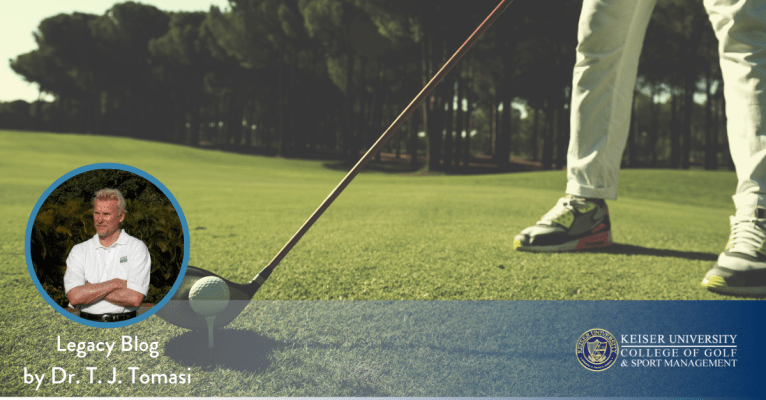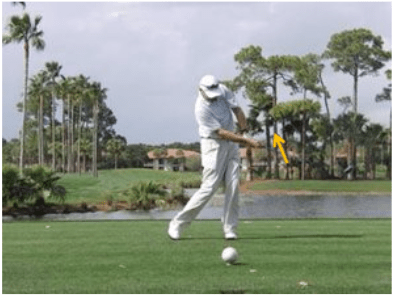Golf Success is Earned, Not Inherited

A Legacy Post by Keiser University College of Golf Senior Faculty and Director of Research Dr. T. J. Tomasi (1940-2023)
There is no doubt that golf is a difficult game, but do you have to be born with superstar reflexes, the eyesight of an eagle, and the strength of an NFL lineman to be a good player? Not according to Matthew Syed, a former Olympian who has written a book called “Bounce” in which he makes the case that success is more a matter of good instruction, a superior place to practice and the will to work hard than it is a heaping helping of inborn talent. Basically, he’s saying that it’s not so much genetics as it is “epigenetics,” and he uses as an example Olympic skaters who fall more in practice than lesser skaters: “The reason is they are always pushing themselves, they are attempting jumps that are at the outer limits of their capabilities. It’s a branch of science called ‘epigenetics’ — the brain is re-wired as we practice.”
In 1953, researchers James Watson and Francis Crick made one of science’s most important discoveries: how genetic instructions are passed from one human to another via DNA. It is indeed wondrous how we know to make a nose and not a knee, but there is one drawback to the process: It is slow — too slow to ensure that humans can adjust to fast-changing environments. Thus, in addition to DNA, there is a fast track avenue of chemical switches that turns your genes on and off in order to foster time-dependent adaptation — more a stopwatch than a sundial. Epigenomes respond to the outside world based on things like stress, diet, and, of course, golf practice. Certainly, you are your DNA, but that’s only part of the story — another part is where a good environment and practice come in.
Still, while we have all the mechanisms for success built-in, life comes at you so fast that you can’t just sit back and let genetics/epigenetics run the show – at some point, you have to engineer effective interventions. In golf, that means being able to trouble-shoot your swing and correct errors, and this process is dependent on a keen sense of cause and effect.
Epigenetics and Golf
Epigenetics, the study of how external factors influence gene expression without altering the underlying DNA sequence, is increasingly becoming a topic of interest in the realm of golf performance. Research suggests that various environmental factors, such as diet, exercise, stress, and even golfing technique, can influence gene expression patterns that impact athletic performance. While epigenetic modifications may play a role in the heritability of golfing abilities, for the average and most players, golf success is predominantly earned through hard work, practice, and effort.
While epigenetic modifications may play a role in developing physical attributes and motor skills crucial for golf, they are not a substitute for the hours of dedicated practice required to excel. These factors may provide a competitive edge for a select few, they are merely one part of a broader picture. For most golfers, success on the course is a result of persistent practice, strategic learning, and the continuous honing of skills. Consistent practice, dedication to learning, and refining techniques are the fundamental keys to achieving and maintaining success in the sport. The combination of these efforts, more than any genetic advantage, defines a golfer’s journey to excellence.
Golf Success
New: Success in golf often hinges on a combination of natural talent, rigorous training, and timely intervention to address performance challenges. Epigenetics has been found to play a crucial role in shaping an individual’s physical attributes and skill development. By understanding the interplay between environmental factors and gene expression, coaches and players can tailor interventions to optimize swing performance. For instance, targeted training programs can be designed to activate specific genes associated with muscle development, coordination, and proprioception, thereby enhancing swing mechanics and power generation.
Intervention at the right time is essential in golf, as minor adjustments in technique or mindset can have significant impacts on performance outcomes. By leveraging epigenetic insights, coaches can identify optimal training periods and methodologies to capitalize on windows of opportunity for skill acquisition and refinement. Moreover, interventions aimed at promoting mental resilience, focus, and emotional regulation can positively influence performance under pressure, allowing players to maintain composure and execute successful shots when it matters most. Overall, a strategic approach to intervention informed by epigenetic principles can contribute to improved swing performance and long-term success in golf.
Identifying the Cause
Repairing your golf swing sounds easy — all you do is identify the fault and fix it. But there is an important step many fail to take: Finding the correct cause of the error. Below is a common problem called the chicken wing, where the lead elbow juts out through impact in an attempt to prevent the club from flipping over (see the second photo). In this case, since I know the player’s swing, I can tell you that at address, his grip is too strong for the rest of his swing. You can see the result when the club slows down during the transition at the top— the clubface is shut in the hook position. There are good players such as Dustin Johnson and Graeme McDowell who play shut, but most golfers don’t do well with a shut face. And it doesn’t take but a few snap hooks before anyone with an ounce of talent chicken-wings to keep the face open.
In this case, focusing on the release, the hip action or some other suspect will not fix the cause, because even though this chicken-wing occurs through impact, the cause is far away – the grip at address.

As the arrow shows, the club face points at the sky in a shut position, a harbinger of the pull and pull hook.

You fix this fault by tracing the chain of error back to the root of the problem — otherwise, it will never go away.
Takeaway
Intervention at the right time can keep your swing healthy, but it has to be intervention keyed by an understanding of causation. Making random changes in your swing to cure a bad ball flight without finding the cause is like rearranging deck chairs on the Titanic – it won’t save you from a bad ending.
Learn more!
Want more tips? If you want to take your game to the next level, contact our team at Keiser University’s College of Golf & Sport Management today. With our dedication and experience, we can elevate your game to new heights together. Give us a call today at 888-355-4465.














